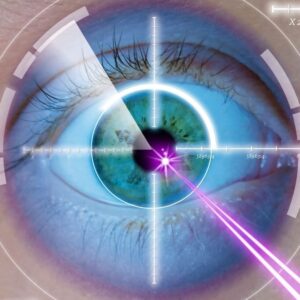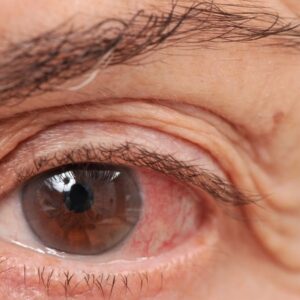What is Dry Eye Syndrome?
Dry eye syndrome is an ocular disorder caused by a lack of lubrication and moisture on the eye’s surface. It occurs when there is insufficient production of tears or when tears evaporate too quickly, resulting in uncomfortable symptoms such as burning, stinging, itching, and dryness of the eye.
If left untreated, dry eye syndrome can lead to severe problems such as vision loss and corneal damage.
What Causes Dry Eye Syndrome?
Dry eye syndrome is an uncomfortable, chronic condition that occurs when the eyes either do not produce enough tears or evaporate too quickly. This can cause the eyes to become dry, red, and uncomfortable. There are several possible causes of dry eye syndrome, including:
- Aging: As people get older, they tend to produce fewer tears, which can lead to dry eye syndrome.
- Medical conditions: Dry eye syndrome can also be caused by diseases or medical conditions like rheumatoid arthritis, Sjogren’s Syndrome, and diabetes.
- Medications: Some medications, such as antihistamines, decongestants, and blood pressure medications, can cause dry eye syndrome as a side effect.
- Environmental factors: Dry, windy, or sunny environments can cause the tears to evaporate too quickly, leading to dry eye syndrome.
- Lifestyle factors: People who spend a lot of time in front of a computer or wear contact lenses are more likely to develop dry eye syndrome.
- Hormonal changes: One potential cause of dry eye syndrome is hormonal imbalances. This is especially common during menopause when many women experience drops in estrogen and other hormones, which can lead to symptoms of dry eyes.
Symptoms of Dry Eye Syndrome
The symptoms of dry eye syndrome can vary from person to person, but common symptoms include the following:
- Dry, scratchy, or burning eyes
- Stringy discharge from the eyes
- Light sensitivity
- Eye fatigue
- Difficulty wearing contact lenses
- Red, swollen eyes
- Blurred vision
Dry eye syndrome can be treated with over-the-counter artificial tears, prescription eye drops, or other medications. In some cases, more intensive treatment may be necessary.
You must see an eye doctor if you have any of these symptoms to determine the cause and receive proper treatment.
Dry Eye Categories
You might encounter different categories of dry eyes, such as:
- It’s possible to get evaporative dry eye when the meibomian glands do not produce enough meibum, leading to the tear film evaporating quickly. You can get dry eye syndrome because of meibomian gland dysfunction.
- If the lacrimal glands cannot produce the watery fluid, it would lead to aqueous dry eye deficiency.
Depending on the type of dry eye you are suffering from, the eye doctor can suggest the most viable option!
Diagnosis of Dry Eye Syndrome
There are several tests that an eye doctor can use to diagnose dry eye syndrome:
- The Schirmer test measures tear production by placing a small strip of paper under your lower eyelid to see how much moisture it absorbs.
- The tear breakup time test measures the time it takes for your tears to evaporate. This test is done by putting a few drops of dye in your eye and then measuring the time it takes for the dye to spread out and disappear.
- The fluorescein stain test uses a special dye to highlight any damage to the front surface of your eye. The dye is applied to your eye, and a special light is used to see where the dye has stuck.
- The meibomian gland test involves gently pressing the eyelid to express a small amount of oil from the meibomian glands. The oil is then examined to see if it is thick and sticky, which can signify meibomian gland dysfunction.
Your eye doctor may also ask you about your symptoms and medical history and perform a thorough eye examination to help diagnose dry eye syndrome.
Smartphone Use Linked to Dry Eye in School Children

It is possible that excessive use of smartphones and other digital devices may contribute to dry eye syndrome in children. These devices emit blue light, which has been shown to interfere with the production of the sleep hormone melatonin and disrupt the body’s natural sleep-wake cycle. This can lead to fatigue and dry, irritated eyes.
In addition, when children use smartphones or other devices for long periods of time, they tend to blink less frequently. This can lead to dry eye syndrome because the tears that keep the eyes moist and comfortable are not being spread evenly over the surface of the eye.
To help prevent dry eye syndrome in children, it is vital to encourage them to take breaks from screens and to blink frequently while using these devices. It may also be helpful to use a blue light filter on the screens to reduce the amount of blue light that is emitted.
If you are concerned about your child’s use of smartphones or other digital devices, it is a good idea to discuss your concerns with a pediatrician or an eye doctor.
Dry Eye Syndrome Complications
Dry eye syndrome can lead to several complications if left untreated. Some of these complications include:
- Eye infections: Dry eye syndrome can cause a breakdown of the eye’s surface, making it more prone to infection.
- Corneal ulcers: Dry eye syndrome can cause a painful sore on the surface of the eye called a corneal ulcer.
- Vision loss: In severe cases, dry eye syndrome can cause scarring on the cornea, leading to vision loss.
- Damage to the front surface of the eye: Dry eye syndrome can cause damage to the cornea, which can lead to vision problems.
- Eyelid inflammation: Dry eye syndrome can cause inflammation of the eyelids, called blepharitis.
See an ophthalmologist if you are experiencing dry eye symptoms, as early treatment can help prevent these complications.
What Treatments are Available for Dry Eye Syndrome?
There are several treatments available for dry eye syndrome, including:
- Artificial tears: Over-the-counter artificial tears can help lubricate the eyes and relieve dry eye symptoms.
- Prescription eye drops: Your eye doctor may prescribe eye drops that are specifically formulated to treat dry eye syndrome. These may include medications that help to increase tear production or reduce inflammation.
- Punctal plugs: Punctal plugs are small devices inserted into the tear ducts to help retain eye moisture.
- Lipiflow: This non-invasive procedure uses heat and pressure to unclog the glands that produce tears.
- Eye ointments: Eye ointments can be used at night to provide lubrication and moisture to the eyes while you sleep.
- Nutritional supplements: Some studies have suggested that certain nutritional supplements, such as omega-3 fatty acids, may help to reduce dry eye symptoms.
Working with your eye doctor to determine the best treatment approach for your specific needs is essential. Sometimes, a combination of treatments may be necessary to manage dry eye syndrome effectively.
Tips for Preventing Dry Eye Symptoms
Several tips you can do to help prevent dry eye symptoms:
- Blink frequently to keep your eyes moist.
- Use a humidifier in your home, especially during the dry winter months.
- Avoid using fans or ventilators that blow air directly into your face.
- Protect your eyes from wind and cold by wearing sunglasses or goggles.
- Avoid smoking, as it irritates your eyes and contributes to dry eyes.
- Take breaks from screens and other activities that require you to focus on your eyes for long periods.
If you spend a significant portion of your day working on a computer, it is helpful to use a special screen that filters out blue light. This can help reduce eye strain and dry eye symptoms.
In addition, you can use artificial tears or other over-the-counter eye drops to help lubricate your eyes and keep them moist. If your dry eye symptoms are severe or do not improve with these self-care measures, you may need to see an eye doctor for further treatment.
When To See an Eye Doctor
You must see an eye doctor if you are experiencing any of the following symptoms:
- Persistent dryness, scratchiness, or grittiness in the eyes
- Burning or stinging sensation in the eyes
- Itching of the eyes
- Redness of the eyes
- Sensitivity to light
- Discomfort or pain when wearing contact lenses
- Blurred vision or difficulty seeing clearly
These symptoms may be indicative of dry eye syndrome and should be evaluated. An eye doctor can thoroughly examine and recommend treatment options to help alleviate your symptoms and prevent potential complications.






